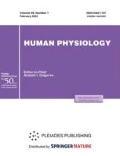Abstract
Long-term exposure to the climatic and social factors of the North cause desynchronization of the human circadian system, which can lead to an increase in the risk of age-associated diseases. Earlier, on a small sample, I showed that the higher the latitude at which a person resides in the North, the higher the frequency of the late chronotype. In addition, the parameters of diurnal rhythm in a late-chronotype subject are less expressed than in an early-chronotype one. The purpose of this study was to estimate the frequency distribution of various chronotypes depending on the latitude at which a person resides. Chronotypes were assessed by the Munich Chronotype Questionnaire (MCTQ). My study included 772 inhabitants of the Republic of Komi. It was shown that there was a significant northward trend towards a higher prevalence of the late chronotype. Thus, an increase in the frequency of the late chronotype, whose circadian rhythm is most sensitive to the negative action of climatic and social factors of the North, may be one of the causes of its desynchronization and an increase in the risk of age-associated diseases in northerners.
Similar content being viewed by others
References
Kaznacheev, V.P., Sovremennhye aspekty adaptatsii (Contemporary Aspects of Adaptation), Novosibirsk: Nauka, 1980.
Filipski, E., King, V.M., Li, X.M., Granda, T.G., Mormont, M.C., Liu, X., et al., Host Circadian Clock As a Control Point in Tumor Progression, J. Natl. Cancer. Inst., 2002, vol. 94, p. 690.
Stevens, R.G., Circadian Disruption and Breast Cancer: From Melatonin to Clock Genes, Epidemiology, 2005, vol. 16, no. 2, p. 254.
Anisimov, V.N. and Vinogradova, I.A., Light Conditions, Melatonin, and the Risk of Cancer, Vopr. Onkol., 2006, vol. 52, no. 5, p. 491.
Anisimov, V.N., Ailamazyan, E.K., Baturin, D.A., Zabezhinskii, M.A., et al., Light Conditions, Anovulation, and Risk of Malignant Neoplasms in the Female Reproductive System, Zh. Akush. Zhensk. Bol., 2003, vol. 52, no. 2, p. 47.
Borisenkov, M.F., The Effect of Natural Illumination in the Period of Midnight Sun and Melatonin on the Diurnal Dynamics of the Total Antioxidant Activity of Human Saliva, Usp. Gerontol., 2007, vol. 20, no. 2, p. 76.
Borisenkov, M.F., The Effect of the State of the Earth’s Magnetic Field on the Diurnal Dynamics of the Total Antioxidant Activity of Human Saliva in the North, Usp. Gerontol., 2007, vol. 20, no. 4, p. 56.
Borisenkov, M.F., Seasonal Changes in the Diurnal Rhythm of Total Antioxidant Activity of Human Saliva, Fiziol. Chel., 2008, vol. 34, no. 1, p. 132.
Borisenkov, M.F., Sketches to the Physiological Portrait of Humans in the North: Oncogerontological Aspect, in Problemy gerontologii i geriatrii-2008 (Problems of Gerontology and Geriatrics 2008) (Proc. IV Regional Scientific and Practical Conference of the Northwestern Federal Region in the Framework of IV International Northern Social and Ecological Congress), St. Petersburg: GO RAN, 2008.
Borisenkov, M.F., Perminova, E.V., and Kosova, A.L., Diurnal Rhythm of Antioxidant Activity of Saliva and Chronotype in Residents of Northern Cities, in Gerontologiya: ot kardiologii k sotsial’no-ekonomicheskim aspektam (Gerontology: From Cardiology to Social and Economic Aspects) (Proc. Regional Scientific and Practical Conference of the Northwestern Federal Region in the Framework of V International Northern Social and Ecological Congress), St. Petersburg, 2009, p. 75.
Roenneberg, T., Wirz-Justice, A., and Merrow, M., Life between the Clocks: Daily Temporal Patterns of Human Chronotypes, J. Biol. Rhythms, 2003, vol. 18, no. 1, p. 80.
Roenneberg, T. and Merrow, M., Entrainment of the Human Circadian Clock, Cold Spring Harb. Symp. Quant. Biol., 2007, vol. 72, p. 293.
Roenneberg, T., Kuehnle, T., Pramstaller, P.P., et al., A Marker for the End of Adolescence, Curr. Biol., 2004, vol. 14, no. 24, p. 1038.
Plokhinskii, N.A., Biometriya (Biometry), Novosibirsk: AN SSSR, 1961.
Roenneberg, T., Kuehnle, T., Juda, M., et al., Epidemiology of the Human Circadian Clock, Sleep Med. Rev., 2007, vol. 11, no. 6, p. 429.
Koskenvuo, M., Hublin, C., Partinen, M., et al., Heritability of Diurnal Type: A Nationwide Study of 8753 Adult Twin Pairs, J. Sleep Res., 2007, vol. 16, p. 156.
Toh, K.L., Jones, C.R., He, Y., et al., An hPer2 Phosphorylation Site Mutation in Familial Advanced Sleep Phase Syndrome, Science, 2001, vol. 291, p. 1040.
Xu, Y., Padiath, Q.S., Shapiro, R.E., et al., Functional Consequences of a CKIdelta Mutation Causing Familial Advanced Sleep Phase Syndrome, Nature, 2005, vol. 434, p. 640.
Jones, C.R., Campbell, S.S., Zone, S.E., et al., Familial Advanced Sleep-Phase Syndrome: A Short-Period Circadian Rhythm Variant in Humans, Nat. Med., 1999, vol. 5, p. 1062.
Roenneberg, T., Kumar, C.J., and Merrow, M., The Human Circadian Clock Entrains to Sun Time, Curr. Biol., 2007, vol. 17, no. 2, p. R44.
Kantermann, T., Juda, M., Merrow, M., and Roenneberg, T., The Human Circadian Clock’s Seasonal Adjustment Is Disrupted by Daylight Saving Time, Curr. Biol., 2007, vol. 17, no. 22, p. 1996.
Wittmann, M., Dinich, J., Merrow, M., and Roenneberg, T., Social Jetlag: Misalignment of Biological and Social Time, Chronobiol. Int., 2006, vol. 23, nos. 1–2, p. 497.
Giannotti, F., Cortesi, F., Sebastiani, T., and Ottaviano, S., Circadian Preference, Sleep and Daytime Behaviour in Adolescence, J. Sleep Res., 2002, vol. 11, p. 191.
Russo, P.M., Bruni, O., Lucidi, F., Ferri, R., and Violani, C., Sleep Habits and Circadian Preference in Italian Children and Adolescents, J. Sleep Res., 2007, vol. 16, p. 163.
Randler, C., Differences Between Smokers and Nonsmokers in Morningness-Eveningness, Social Behav. Personality, 2008, vol. 36, no. 5, p. 673.
Gau S.F., Shang C.Y., Merikangas K.R., et al., Association between Morningness-Eveningness and Behavioral-Emotional Problems among Adolescents, J. Biol. Rhythms, 2007, vol. 22, p. 268.
Author information
Authors and Affiliations
Additional information
Original Russian Text © M.F. Borisenkov, 2010, published in Fiziologiya Cheloveka, 2010, Vol. 36, No. 3, pp. 117–122.
Rights and permissions
About this article
Cite this article
Borisenkov, M.F. Human chronotypes in the North. Hum Physiol 36, 348–352 (2010). https://doi.org/10.1134/S0362119710030151
Received:
Published:
Issue Date:
DOI: https://doi.org/10.1134/S0362119710030151




